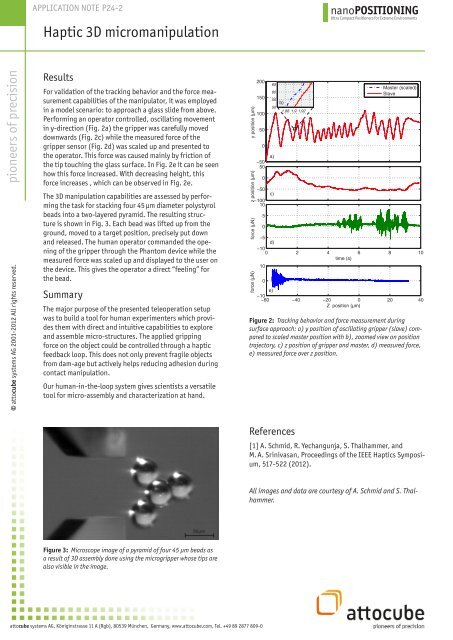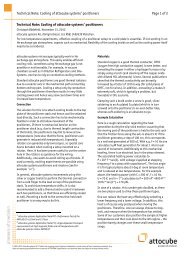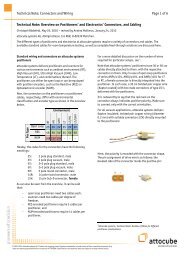nanoPOSITIONING - attocube
nanoPOSITIONING - attocube
nanoPOSITIONING - attocube
Create successful ePaper yourself
Turn your PDF publications into a flip-book with our unique Google optimized e-Paper software.
pioneers of precision<br />
© <strong>attocube</strong> systems AG 2001-2012 All rights reserved.<br />
APPLICATION NOTE P24-2<br />
Haptic 3D micromanipulation<br />
Results<br />
For validation of the tracking behavior and the force measurement<br />
capabilities of the manipulator, it was employed<br />
in a model scenario: to approach a glass slide from above.<br />
Performing an operator controlled, oscillating movement<br />
in y-direction (Fig. 2a) the gripper was carefully moved<br />
downwards (Fig. 2c) while the measured force of the<br />
gripper sensor (Fig. 2d) was scaled up and presented to<br />
the operator. This force was caused mainly by friction of<br />
the tip touching the glass surface. In Fig. 2e it can be seen<br />
how this force increased. With decreasing height, this<br />
force increases , which can be observed in Fig. 2e.<br />
The 3D manipulation capabilities are assessed by performing<br />
the task for stacking four 45 µm diameter polystyrol<br />
beads into a two-layered pyramid. The resulting structure<br />
is shown in Fig. 3. Each bead was lifted up from the<br />
ground, moved to a target position, precisely put down<br />
and released. The human operator commanded the opening<br />
of the gripper through the Phantom device while the<br />
measured force was scaled up and displayed to the user on<br />
the device. This gives the operator a direct “feeling” for<br />
the bead.<br />
Summary<br />
The major purpose of the presented teleoperation setup<br />
was to build a tool for human experimenters which provides<br />
them with direct and intuitive capabilities to explore<br />
and assemble micro-structures. The applied gripping<br />
force on the object could be controlled through a haptic<br />
feedback loop. This does not only prevent fragile objects<br />
from dam-age but actively helps reducing adhesion during<br />
contact manipulation.<br />
Our human-in-the-loop system gives scientists a versatile<br />
tool for micro-assembly and characterization at hand.<br />
<strong>attocube</strong> systems AG, Königinstrasse 11 A (Rgb), 80539 München, Germany, www.<strong>attocube</strong>.com, Tel. +49 89 2877 809-0<br />
����<br />
Figure 3: Microscope image of a pyramid of four 45 µm beads as<br />
a result of 3D assembly done using the microgripper whose tips are<br />
also visible in the image.<br />
y position (µm)<br />
z position (µm)<br />
force (µN)<br />
force (µN)<br />
200<br />
150<br />
100<br />
50<br />
0<br />
a)<br />
−50<br />
50<br />
0<br />
−50<br />
c)<br />
−100<br />
10<br />
5<br />
0<br />
65<br />
60<br />
55<br />
b)<br />
50<br />
1,88 1,9 1,92<br />
<strong>nanoPOSITIONING</strong><br />
Ultra Compact Positioners for Extreme Environments<br />
−5<br />
d)<br />
−10<br />
0 2 4 6 8 10<br />
time (s)<br />
10<br />
0<br />
e)<br />
−10<br />
−60 −40 −20 0 20 40<br />
Z position (µm)<br />
Figure 2: Tracking behavior and force measurement during<br />
surface approach: a) y position of oscillating gripper (slave) compared<br />
to scaled master position with b), zoomed view on position<br />
trajectory, c) z position of gripper and master, d) measured force,<br />
e) measured force over z position.<br />
References<br />
Master (scaled)<br />
Slave<br />
[1] A. Schmid, R. Yechangunja, S. Thalhammer, and<br />
M. A. Srinivasan, Proceedings of the IEEE Haptics Symposium,<br />
517-522 (2012).<br />
All images and data are courtesy of A. Schmid and S. Thalhammer.





